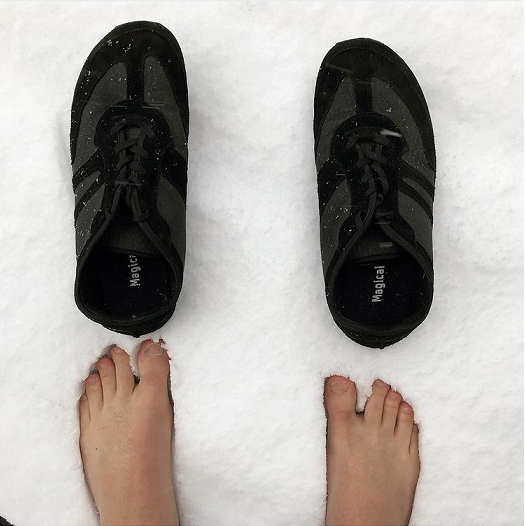
If you train to run all year round, you’re probably no stranger to running in the snow. You may even have special sports shoes designed for this purpose. But are you brave enough to leave them at home and try barefoot running in the snow?
For anyone who wants to get started, barefoot snow running is initially a completely new skill that requires practice and adaptation of the body to the extreme thermal conditions.
Preparing feet for low temperatures
Start by regularly exposing your feet to cooler weather and getting them used to the cold ground temperature. These can be short (5-6 min) walks or trotting in the garden, around the block or along the street. You can start in autumn and harden your feet for a few weeks. Remember to take care of the right clothing already then, which will serve you later during barefoot training in the snow. If barefoot running is new to you, we suggest you start by practising natural running in minimalist shoes.
Clothing for barefoot running in winter
The right clothing is crucial to maintaining an uninterrupted flow of heat energy in the body while running. This is because the body first uses up heat resources to warm up the area around the heart and chest, and only then takes care of transporting the energy surplus to the hands and feet. It is therefore essential that your body has reliable protection against the cold and wet. Here are the clothing items you must not forget:
- a hat – preferably lightweight and breathable and made of windstopper fabric,
- thermal underwear – especially a long-sleeved T-shirt and leggings made from fabrics that can cope with excess perspiration (women also need a sports bra with moisture-wicking properties),
- a lightweight jacket for running in winter conditions that allows air to circulate but does not lose heat.
Recently, clothing made from merino wool (so-called merino clothing) has been conquering the market, which helps to keep heat next to the skin in winter conditions. We recommend. Avoid cotton, on the other hand, as it does not cope very well with excess moisture.
First training plan
Set a short undemanding route to start with, preferably on pavement, street, marked park paths or grass. It is best to choose flat and level surfaces and to run on snow that has not yet started to melt, but is fresh or possibly several days old and well compressed.
Also pay attention to whether by chance the snow on your chosen route is sprinkled with salt. This will damage the skin on your feet and expose you to an unpleasant burning sensation. If you inadvertently run on such snow, stop your workout and wash your feet thoroughly and keep your skin moisturised when you get home.
Well, let’s get on with it!
Let’s start by saying that going barefoot in the snow for the first time may require a bit of determination, so it’s worth resolving even before you take off your shoes that, whatever happens, you will stay barefoot in the snow for at least five minutes.
Additional motivation, as well as a sense of security, will be added by having someone close to you cheering you on.
A key element of winter training is the warm-up. Start it indoors and make sure it is dynamic enough. Once outside, continue warming up in your shoes for a while. When you feel your feet are sufficiently warmed up, you can take off your shoes and socks.
Remember to stay in motion at all times when you are barefoot. If you are not running, jog in place so that your circulatory system can keep pumping blood to your feet. Your feet will get a thermal shock at first, but after a maximum of 10 minutes of running they will have warmed up sufficiently for the discomfort to pass.
First training sessions
During your first training sessions, have minimalist footwear with you as an emergency. If, for any reason, you feel a great deal of discomfort, a sudden significant drop in body temperature or a poignant cold in your feet, don’t strain, but put on your shoes and head for home. The body is always right.
Also remember not to overdo the distance or running speed during your first snow workouts. Also set yourself a low cadence (take small steps), which will allow a steady, even flow of heat to your feet.
We wish you the best of luck. Be sure to let us know in the comments how it went for you.

Leave a Reply